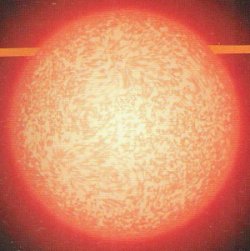Difference between revisions of "Aldebaran system"
From Trekipedia
m |
m |
||
| Line 2: | Line 2: | ||
{{ImageInfoBox2|name=Aldebaran system|file=star_type-k-stsc.jpg|caption=K-Type Star ({{STSC}})}} | {{ImageInfoBox2|name=Aldebaran system|file=star_type-k-stsc.jpg|caption=K-Type Star ({{STSC}})}} | ||
{{TableRow|title=Affiliation|data=[[United Federation of Planets|UFP]]}} | {{TableRow|title=Affiliation|data=[[United Federation of Planets|UFP]]}} | ||
| − | {{TableRow|title=First Appearance|data={{ | + | {{TableRow|title=First Appearance|data={{TOS02}} ([[1966 (Production)#SEP22|22 Sep 1966]])}} |
{{Ad|AmazonTOSBD}} | {{Ad|AmazonTOSBD}} | ||
{{Ad|AmazonDS9DVD}} | {{Ad|AmazonDS9DVD}} | ||
|}</div> | |}</div> | ||
{{BannerPrime}} | {{BannerPrime}} | ||
| − | The star Aldebaran was a K-Type star located 68 light-years from the [[Sol system]], where it was named and sighted as one of the brightest in the night sky by [[Earth]]'s ancient inhabitants. Aldebaran was also known by its old Earth Bayer classification of Alpha Tauri.<ref name="STSC"/> It had at least five planets,<ref name="DSN436"/> one of which was home to the [[Aldebaran Music Academy]],<ref name="TOS40"/> as well as the [[Aldebaran Colony]]<ref name="TOS01"/> and planet [[Aldebaran III]].<ref name="TOS40"/><ref name="DSN457"/> [[Doctor]] [[Elizabeth Dehner]] joined the crew of the [[U.S.S. Enterprise NCC-1701|U.S.S. ''Enterprise'' NCC-1701]] from the Aldebaran Colony.<ref name=" | + | The star Aldebaran was a K-Type star located 68 light-years from the [[Sol system]], where it was named and sighted as one of the brightest in the night sky by [[Earth]]'s ancient inhabitants. Aldebaran was also known by its old Earth Bayer classification of Alpha Tauri.<ref name="STSC"/> It had at least five planets,<ref name="DSN436"/> one of which was home to the [[Aldebaran Music Academy]],<ref name="TOS40"/> as well as the [[Aldebaran Colony]]<ref name="TOS01"/> and planet [[Aldebaran III]].<ref name="TOS40"/><ref name="DSN457"/> [[Doctor]] [[Elizabeth Dehner]] joined the crew of the [[U.S.S. Enterprise NCC-1701|U.S.S. ''Enterprise'' NCC-1701]] from the Aldebaran Colony.<ref name="TOS02"/> One of the species native to Aldebaran was the [[Aldebaran shellmouth]].<ref name="TOS34"/> |
{{Wikipedia|Aldebaran}} | {{Wikipedia|Aldebaran}} | ||
{{References}} | {{References}} | ||
<references> | <references> | ||
| − | <ref name=" | + | <ref name="TOS02">{{RefTOS02}}</ref> |
<ref name="TOS34">{{RefTOS34}}</ref> | <ref name="TOS34">{{RefTOS34}}</ref> | ||
<ref name="TOS40">{{RefTOS40}}</ref> | <ref name="TOS40">{{RefTOS40}}</ref> | ||
Revision as of 00:06, 30 March 2023
Myriad Universes: Aldebaran system
Aldebaran system
| Affiliation | UFP |
| First Appearance | TOS02 (22 Sep 1966) |
| Advertising | |
| Advertising |
The star Aldebaran was a K-Type star located 68 light-years from the Sol system, where it was named and sighted as one of the brightest in the night sky by Earth's ancient inhabitants. Aldebaran was also known by its old Earth Bayer classification of Alpha Tauri.[1] It had at least five planets,[2] one of which was home to the Aldebaran Music Academy,[3] as well as the Aldebaran Colony[4] and planet Aldebaran III.[3][5] Doctor Elizabeth Dehner joined the crew of the U.S.S. Enterprise NCC-1701 from the Aldebaran Colony.[6] One of the species native to Aldebaran was the Aldebaran shellmouth.[7]
Notes and References
- ↑ Mandel, Geoffrey. Star Trek: Star Charts. Pocket Books, 2002.
- ↑ "Shadowplay." Star Trek: Deep Space Nine, Episode 436. Paramount Pictures Corporation, 21 February 1994.
- ↑ 3.0 3.1 Roddenberry, Gene (Executive Producer). "The Deadly Years." Star Trek, Season 2, Episode 11. Directed by Joseph Pevney. Written by David P. Harmon. Desilu Productions, 8 December 1967.
- ↑ Cite error: Invalid
<ref>tag; no text was provided for refs namedTOS01 - ↑ Berman, Rick et al (Executive Producers). "Past Tense, Part I". Star Trek: Deep Space Nine, season 3, episode 11 (Production number 457). Directed by Rea Badiyi. Story by Ira Steven Behr and Robert Hewitt Wolfe. Teleplay by Robert Hewitt Wolfe. Paramount Pictures. 2 January 1995.
- ↑ Roddenberry, Gene (Executive Producer). "Where No Man Has Gone Before". Star Trek, season 1, episode 3 (Production number 02). Directed by James Goldstone. Written by Samuel A. Peeples. Desilu Productions. 22 September 1966.
- ↑ Roddenberry, Gene (Executive Producer). "Amok Time." Star Trek, Season 2, Episode 5. Directed by Joseph Pevney. Written by Theodore Sturgeon. Desilu Productions, 15 September 1967.


